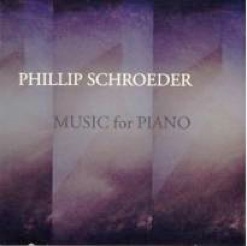
Here (and there)
Jeri-Mae G. Astolfi
2013 / innova Recordings
66 minutes
Review by Kathy Parsons
Here (and there) is a collection of six pieces for piano and electronics composed for and performed by Jeri-Mae G. Astolfi. Astolfi is the rare artist who seems as comfortable with traditional classics as she is with this much more experimental music. I first became aware of her astonishing pianism on Phillip Schroeder’s 2005 release, Music for Piano, and her recordings never fail to impress. A member of the music faculty of the University of Wisconsin Oshkosh, Astolfi has commissioned and premiered many new solo and collaborative works and has received numerous awards and grants. That said, some of this music is very challenging, so if you are looking for soothing, melodic piano music to relax with, you’d probably better move on. On the other hand, this is a fascinating look at some of the directions Contemporary American classical music is moving in. Five of the six composers are teachers at the college and university level, and the sixth is the director of an experimental music label. The pieces are all very different from each other and range in duration from 6 1/2 minutes to a little more than eighteen.
Phillip Schroeder’s “Crystal Springs” was inspired by the lush, rugged beauty of Crystal Springs, Arkansas as well as imaginary springs. The three large sections of the piece were designed by use of the Fibonacci series. In addition to the piano, electronically manipulated sounds from an electric bass, a suspended cymbal, and the inside of a piano were used. Sometimes sparkling and sometimes dark and mysterious, this is my favorite track. “Swirling Sky” (Ed Martin) begins peacefully, recalling moments spent watching clouds while lying in the grass. As it progresses, it depicts losing oneself in the moment and being swept through the clouds in an “extraordinary adventure.” Jeff Herriott composed the first version of “green is passing” in 1999 and revised it in 2006 to reflect his evolved composing style. Very quiet and subtle, it creates an atmospheric listening experience that I find hypnotic. The esoteric “Summer Phantoms: Nocturne” is made up of the piano, string scrapes, hand dampened tones, soundboard strikes, and other processed sounds. Tom Lopez’s “Confetti Variations” has an especially interesting story. Astolfi had told Lopez that two of her favorite composers of piano music are Johannes Brahms and Morton Feldman, which set Lopez to dreaming about a Brahms/Feldman/Lopez “mashup” (Lopez’s term). His composition process entailed “shredding Brahms and Feldman piano music into brightly colored fragments, firing the sparkly bits into the air, and listening to them rain down over field recordings” (from the liner notes). Sometimes beautiful and sometimes noisy and chaotic, it is quite an experience! Jim Fox’s “The pleasure of being lost” features the speaking voice of Janyce Collins reading a text freely adapted from the writings of Joseph Dalton Hooker. While the words are often obscured, sounds that accompany the reading are processed from the timbres and rhythms of her voice. The piano and bell tones also accompany the voice - very haunting and mysterious!
If you are a unique listening experience, check out Here (and there)! It is available from www.innova.mu, Amazon, and iTunes.
February 23, 2013

with Phillip Schroeder
2005

